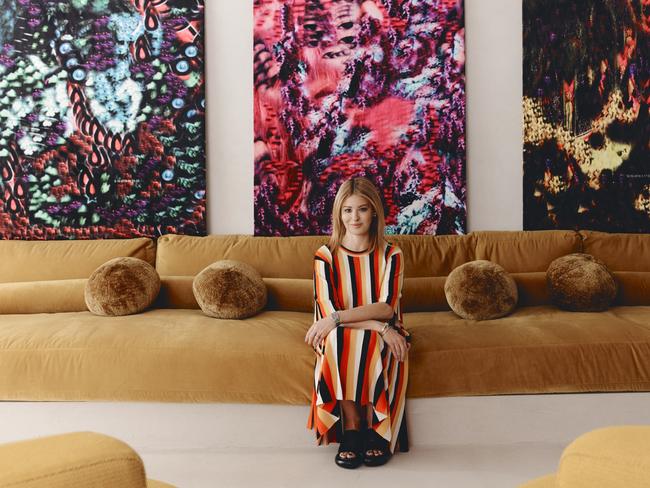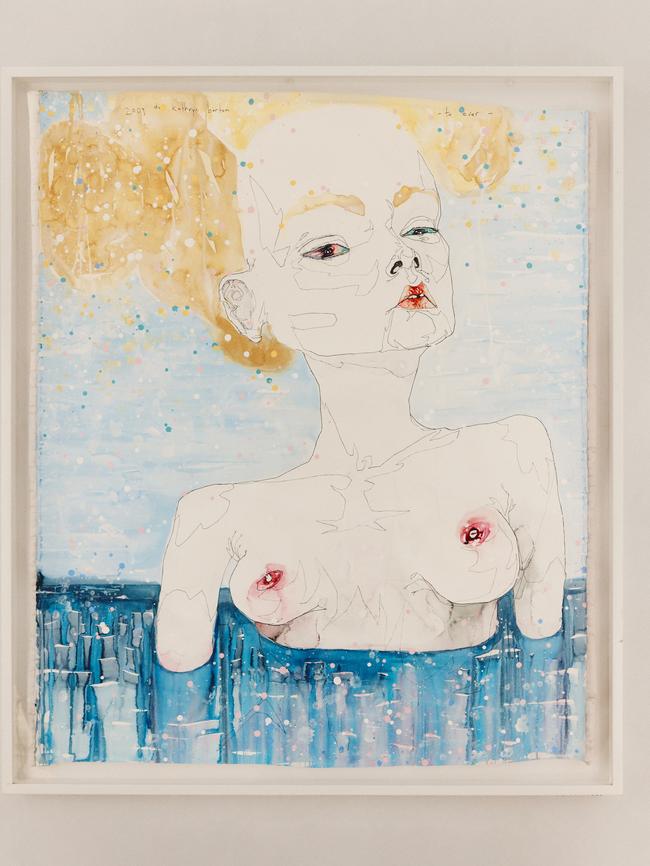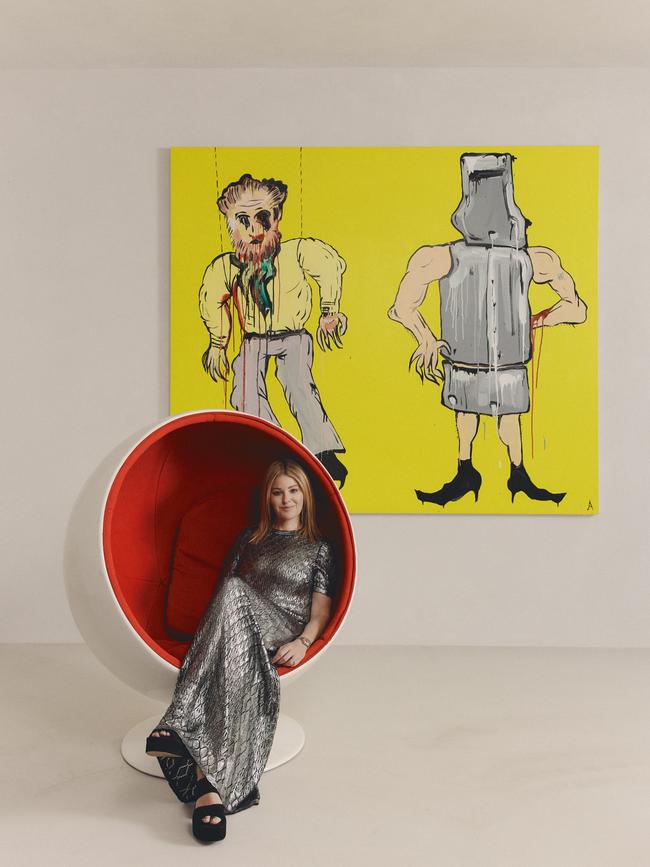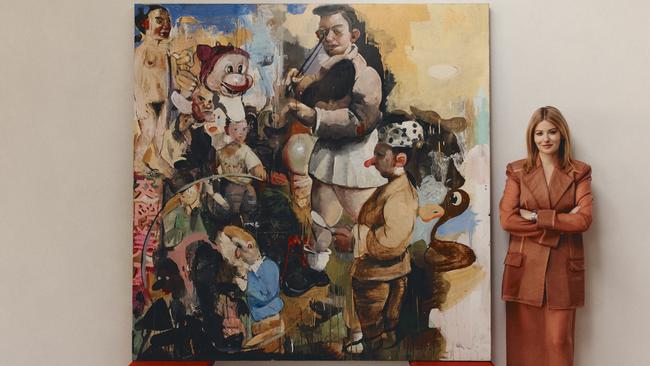Art plays a starring role in this spectacular house
For the director of Sydney’s Parlour X, art and fashion have long been entwined, and never more so than at her newly renovated home.

The first thing you will notice when you walk into the home of Eva Galambos, director of luxury fashion boutique Parlour X and an ambassador for the Museum of Contemporary Art, is a painting by the Australian artist Del Kathryn Barton.
It’s Galambos’s favourite piece. Partly because she always needs to feel something, to intuit a connection, when she buys a piece of art. Partly because the piece – a portrait of a woman, full of whimsy and vibrancy – celebrates women’s stories. This is what interests Galambos.
“This is the one that stood out because, is it Vivienne Westwood? Is it Margaret Thatcher? And also, I kind of have yellowy hair, you know, so there’s kind of this [piece] around the complexities of womanhood. Often Del and I would chat, we talk about our lives and the complexities around our lives, and a lot of it is about being a woman,” says Galambos.
“I still haven’t put up all the art. I think it takes a really long time when you move into somewhere to get a real feel for art, and there’s no rush. The one thing that I was a hundred per cent sure about was that [this piece] was to always go above the fireplace and be the first thing you looked at when you walked into the [room]. Because it’s such a powerful piece and because it also has such a deep emotional connection.”
The pair met when Barton started coming into Parlour X and the women struck up a friendship. “I’m a real connector and I love to connect…[Del] is somebody I connected with so, so quickly,” says Galambos. “I love Del personally. I just think she’s amazing, for her ideals. She’s a progressive, and she has her foray into film and art direction and movie direction; she’s such an incredible storyteller. I think she makes a lot of sense to me because she’s complex. She’s an artist. I mean, what creative person doesn’t have multi-layered complexities? And I was very drawn and attracted to her complexities and her realness around those.”


Other artists she admires include Tracey Moffatt, the wartime photographer Lee Miller, and Frida Kahlo – even if Galambos admits that citing the latter could be construed as something of a cliché.
“[It’s] her storytelling,” she says of being drawn to Kahlo. “The fact that she was never recognised in her day… it makes me think about the thousands of women who were never recognised in their day. Whenever there’s an exhibition that commemorates that, I always want to go and see those works. Female art from an emotional perspective resonates so clearly and so well with me.”
Other pieces in Galambos’s collection elicit a similar emotional reaction – because they came into her life in some kind of serendipitous way or because the connection to the work is sometimes visceral, often calming and occasionally contrary.
This includes a piece by McLean Edwards, the artist known for his dark comic book aesthetic, that Galambos once used to do yoga with. She now thinks she will put it into the kitchen – the family moved into their new home six months ago and things are still settling into place. “As an artist he’s very, very dark,” she says. “But not for me; I love this work. I used to do yoga to this [piece] three times a week and people used to think I was mad; they could not understand – ‘How can you look at that and be calm? How can you be still with something like that’?”
These were common reactions to the piece, a large-scale work depicting a montage of curious characters.
“I see it as a melting pot of anything goes. There are so many characters here, from a duck to a violinist, a Snow White dwarf, masculine, feminine, everything goes here. It doesn’t matter what you are… you could be anything and they all come together listening to his music, they’re all just doing their own thing,” says Galambos.
“I don’t know why, I just found this calming and I loved it. A lot of my friends and people who see it think it’s dark, hectic and scary. My children used to think it was scary. I obviously am attracted to works of art that some people find quite confronting … for me, I just think they’re pure, pure beauty. I don’t see it that way.”

Another favourite is a piece by the late Adam Cullen. Challenging and bold, it hangs in the dining room. Galambos bought it from an art collector friend whose “phenomenal eye” she trusts implicitly. The friend lent it to her when she was selling a previous house. Later he asked her if she’d like to buy it. It was, she says, a really “personal acquisition” – he helped Galambos out and she later helped him.
“I think for me, everything I have that I love has to have some sort of weird story behind it that feels like it really resonates with me,” she says. “I think that’s why I don’t think I will ever rotate certain art that has that background story.”
Galambos, who is a lifelong magpie, collecting things such as coloured glass, crystal goblets and trinkets found in flea markets – French lace doilies, silver spoons – studied fine arts at university. She worked at the Museum of Contemporary Art as a guide and in museum education before moving into fashion. The curatorial side of art is how she approaches her work, and she sees it as an asset.
“I consider myself to be a creative, but I’m not that practically inclined,” she says, “I’m an ideas creative. I’m a relatively good communicator. I’m good at working with someone who’s practically inclined and giving ideas. I just am not very good at physically executing the creative ideas.
“That’s also why maybe I ended up in fashion, more than anything else. Because being a curator, again you’re not the manufacturer, you’re not there drawing and designing. I could say to someone, ‘I could help you in a collection,’ and say, ‘you need a skirt there,’ …[but] I can’t create the prints. I can help with the silhouettes, but I can’t draw it. It made sense that I was always going to have a job in my life that was more curatorial than anything else.”
Something Galambos, who has held many volunteer roles at the Museum of Contemporary Art throughout her years there, is passionate about is philanthropy. Especially in art education and making art accessible for all.
This partly comes from having been immersed in art as a child, an experience for which she remains grateful. She is determined to give her two daughters, aged 10 and 14, the same opportunities.
“When I was a little girl, my parents went through stages of having money, not having money. My parents had my brother and I when they were super young and they both have immigrant parents who came here in difficult circumstances. My dad is an artist, not by vocation [but] he’s really good, and they used to take us to the galleries all the time because it’s free, and it was a beautiful outing and it taught us a lot about art,” she says.
She believes that art gave her a lens through which to see the world, with curiosity. “I developed my sense of justice, my moral values, from my parents taking me to art galleries as a child,” she says. “I know that that shaped me as a human being. And I know that when I still go to exhibitions – it doesn’t always have to be art, any sort of exhibition – the emotional reaction, the understanding of the history, that journey, it’s integral to everything that I love the most in the world.”


